
Concept explainers
(a)
Interpretation:
The compound from given spectra is to be identified.
Concept Introduction:
In the IR spectroscopy, change in the dipole moment produces absorption of energy. All the functional group have different absorption frequency based on which they can be differentiated. For carbonyl
Answer to Problem 21.55AP
The structure of compound is shown below.
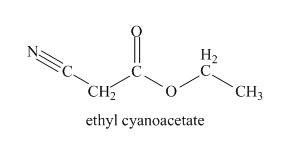
Explanation of Solution
The odd molecular mass of the compound indicates that it contains odd number of nitrogen atoms. Hydroxamate test is given by esters. So, compound contains ester group. The IR band at

Figure 1
The given compound is ethyl cyanoacetate.
(b)
Interpretation:
The compound from given spectra is to be identified.
Concept Introduction:
In the IR spectroscopy, change in the dipole moment produces absorption of energy. All the functional group have different absorption frequency based on which they can be differentiated. For carbonyl
Answer to Problem 21.55AP
The structure of given compound is shown below.
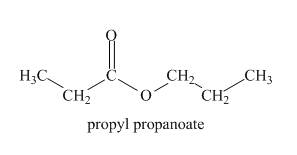
Explanation of Solution
The given compound gives IR absorption peak at

Figure 2
The given compound is propyl propanaote.
(c)
Interpretation:
The compound from given spectra is to be identified.
Concept Introduction:
In the IR spectroscopy, change in the dipole moment produces absorption of energy. All the functional group have different absorption frequency based on which they can be differentiated. For carbonyl
Answer to Problem 21.55AP
The structure of given compound is shown below.
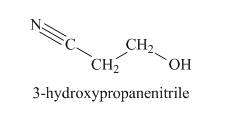
Explanation of Solution
The strong absorption peak in IR at

Figure 3
The given compound is
(d)
Interpretation:
The compound from given spectra is to be identified.
Concept Introduction:
In the IR spectroscopy, change in the dipole moment produces absorption of energy. All the functional group have different absorption frequency based on which they can be differentiated. For carbonyl
Answer to Problem 21.55AP
The structure of given compound is shown below.
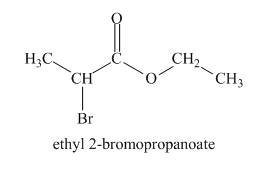
Explanation of Solution
The two molecular ion peaks at

Figure 4
The given compound is
(e)
Interpretation:
The compound from given spectra is to be identified.
Concept Introduction:
In the IR spectroscopy, change in the dipole moment produces absorption of energy. All the functional group have different absorption frequency based on which they can be differentiated. For carbonyl
Answer to Problem 21.55AP
The structure of given compound is shown below.
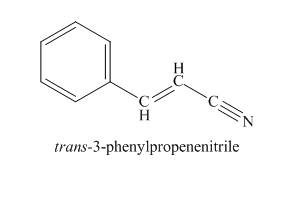
Explanation of Solution
The compound has odd molecular mass which indicates the presence of nitrogen atom. The IR absorption peak at

Figure 5
The given compound is
(f)
Interpretation:
The compound from given spectra is to be identified.
Concept Introduction:
In the IR spectroscopy, change in the dipole moment produces absorption of energy. All the functional group have different absorption frequency based on which they can be differentiated. For carbonyl
Answer to Problem 21.55AP
The structure of given compound is shown below.
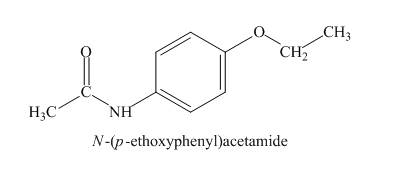
Explanation of Solution
The absorption in IR at ![]() indicates the presence of amide group and at
indicates the presence of amide group and at
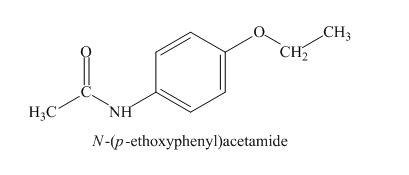
Figure 6
The given compound is
(g)
Interpretation:
The compound from given spectra is to be identified.
Concept Introduction:
In the IR spectroscopy, change in the dipole moment produces absorption of energy. All the functional group have different absorption frequency based on which they can be differentiated. For carbonyl
Answer to Problem 21.55AP
The structure of given compound is shown below.
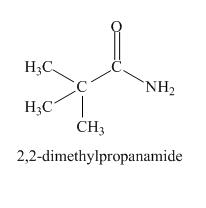
Explanation of Solution
The odd molecular mass of the compound indicates it contains nitrogen atom. The IR absorption peak at

Figure 7
The given compound is
Want to see more full solutions like this?
Chapter 21 Solutions
EBK ORGANIC CHEMISTRY STUDY GUIDE AND S
- 8:17 PM Sun Mar 30 Draw the major product of this reaction. Ignore inorganic byproducts. HSCH2CH2CH2SH, BF3 Probler Drawing Ato Bonds Clarrow_forwardpresented by Mr L How the coprion. (Il Done in no wraction, dew the starting redential) доarrow_forward8:16 PM Sun Mar 30 K Draw the major product of this reaction. Ignore inorganic byproducts. Proble 1. CH3MgBr 2. H3O+ F Drawingarrow_forward
- о но оarrow_forwardName the major organic product of the following action of 4-chloro-4-methyl-1-pentanol in neutral pollution 10+ Now the product. The product has a molecular formula f b. In a singly hain, the starting, material again converts into a secule with the molecular kormula CIO. but with comply Draw the major organic structure inhalationarrow_forwardMacmillan Learning Alcohols can be oxidized by chromic acid derivatives. One such reagent is pyridinium chlorochromate, (C,H,NH*)(CICTO3), commonly known as PCC. Draw the proposed (neutral) intermediate and the organic product in the oxidation of 1-butanol by PCC when carried out in an anhydrous solvent such as CH₂C₁₂. PCC Intermediate OH CH2Cl2 Draw the intermediate. Select Draw Templates More с H Cr о Product Draw the product. Erase Select Draw Templates More H о Erasearrow_forward
- If I have 1-bromopropene, to obtain compound A, I have to add NaOH and another compound. Indicate which compound that would be. A C6H5 CH3arrow_forwardProvide the reagents for the following reactions.arrow_forwardIf I have 1-bromopropene, to obtain compound Z, I have to add two compounds A1 and A2. Indicate which compounds are needed. P(C6H5)3arrow_forward
- Draw the major product of this reaction. Ignore inorganic byproducts. Assume that the water side product is continuously removed to drive the reaction toward products. O CH3CH2NH2, TSOH Select to Draw >arrow_forwardPredict the major organic product(s) for the following reaction.arrow_forwardPredict the major organic product(s) for the following reactions.arrow_forward

 Organic ChemistryChemistryISBN:9781305580350Author:William H. Brown, Brent L. Iverson, Eric Anslyn, Christopher S. FootePublisher:Cengage Learning
Organic ChemistryChemistryISBN:9781305580350Author:William H. Brown, Brent L. Iverson, Eric Anslyn, Christopher S. FootePublisher:Cengage Learning

